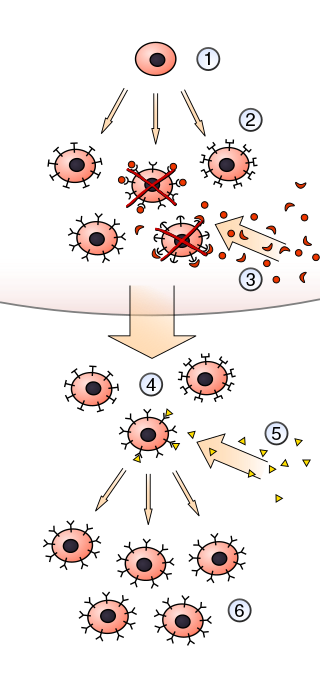Related Research Articles

Immunology is a branch of biology and medicine that covers the study of immune systems in all organisms.

Neural Darwinism is a biological, and more specifically Darwinian and selectionist, approach to understanding global brain function, originally proposed by American biologist, researcher and Nobel-Prize recipient Gerald Maurice Edelman. Edelman's 1987 book Neural Darwinism introduced the public to the theory of neuronal group selection (TNGS) – which is the core theory underlying Edelman's explanation of global brain function.

In computational intelligence (CI), an evolutionary algorithm (EA) is a subset of evolutionary computation, a generic population-based metaheuristic optimization algorithm. An EA uses mechanisms inspired by biological evolution, such as reproduction, mutation, recombination, and selection. Candidate solutions to the optimization problem play the role of individuals in a population, and the fitness function determines the quality of the solutions. Evolution of the population then takes place after the repeated application of the above operators.
In computer science, evolutionary computation is a family of algorithms for global optimization inspired by biological evolution, and the subfield of artificial intelligence and soft computing studying these algorithms. In technical terms, they are a family of population-based trial and error problem solvers with a metaheuristic or stochastic optimization character.
Bio-inspired computing, short for biologically inspired computing, is a field of study which seeks to solve computer science problems using models of biology. It relates to connectionism, social behavior, and emergence. Within computer science, bio-inspired computing relates to artificial intelligence and machine learning. Bio-inspired computing is a major subset of natural computation.
Neuroevolution, or neuro-evolution, is a form of artificial intelligence that uses evolutionary algorithms to generate artificial neural networks (ANN), parameters, and rules. It is most commonly applied in artificial life, general game playing and evolutionary robotics. The main benefit is that neuroevolution can be applied more widely than supervised learning algorithms, which require a syllabus of correct input-output pairs. In contrast, neuroevolution requires only a measure of a network's performance at a task. For example, the outcome of a game can be easily measured without providing labeled examples of desired strategies. Neuroevolution is commonly used as part of the reinforcement learning paradigm, and it can be contrasted with conventional deep learning techniques that use gradient descent on a neural network with a fixed topology.
Swarm intelligence (SI) is the collective behavior of decentralized, self-organized systems, natural or artificial. The concept is employed in work on artificial intelligence. The expression was introduced by Gerardo Beni and Jing Wang in 1989, in the context of cellular robotic systems.
The expression computational intelligence (CI) usually refers to the ability of a computer to learn a specific task from data or experimental observation. Even though it is commonly considered a synonym of soft computing, there is still no commonly accepted definition of computational intelligence.

The adaptive immune system, also known as the acquired immune system, or specific immune system is a subsystem of the immune system that is composed of specialized, systemic cells and processes that eliminate pathogens or prevent their growth. The acquired immune system is one of the two main immunity strategies found in vertebrates.

In immunology, clonal selection theory explains the functions of cells of the immune system (lymphocytes) in response to specific antigens invading the body. The concept was introduced by Australian doctor Frank Macfarlane Burnet in 1957, in an attempt to explain the great diversity of antibodies formed during initiation of the immune response. The theory has become the widely accepted model for how the human immune system responds to infection and how certain types of B and T lymphocytes are selected for destruction of specific antigens.
Computational neurogenetic modeling (CNGM) is concerned with the study and development of dynamic neuronal models for modeling brain functions with respect to genes and dynamic interactions between genes. These include neural network models and their integration with gene network models. This area brings together knowledge from various scientific disciplines, such as computer and information science, neuroscience and cognitive science, genetics and molecular biology, as well as engineering.
In artificial immune systems, clonal selection algorithms are a class of algorithms inspired by the clonal selection theory of acquired immunity that explains how B and T lymphocytes improve their response to antigens over time called affinity maturation. These algorithms focus on the Darwinian attributes of the theory where selection is inspired by the affinity of antigen-antibody interactions, reproduction is inspired by cell division, and variation is inspired by somatic hypermutation. Clonal selection algorithms are most commonly applied to optimization and pattern recognition domains, some of which resemble parallel hill climbing and the genetic algorithm without the recombination operator.
The immune network theory is a theory of how the adaptive immune system works, that has been developed since 1974 mainly by Niels Jerne and Geoffrey W. Hoffmann. The theory states that the immune system is an interacting network of lymphocytes and molecules that have variable (V) regions. These V regions bind not only to things that are foreign to the vertebrate, but also to other V regions within the system. The immune system is therefore seen as a network, with the components connected to each other by V-V interactions.
Natural computing, also called natural computation, is a terminology introduced to encompass three classes of methods: 1) those that take inspiration from nature for the development of novel problem-solving techniques; 2) those that are based on the use of computers to synthesize natural phenomena; and 3) those that employ natural materials to compute. The main fields of research that compose these three branches are artificial neural networks, evolutionary algorithms, swarm intelligence, artificial immune systems, fractal geometry, artificial life, DNA computing, and quantum computing, among others.
Within biological systems, degeneracy occurs when structurally dissimilar components/pathways can perform similar functions under certain conditions, but perform distinct functions in other conditions. Degeneracy is thus a relational property that requires comparing the behavior of two or more components. In particular, if degeneracy is present in a pair of components, then there will exist conditions where the pair will appear functionally redundant but other conditions where they will appear functionally distinct.
Immunology is the study of the immune system during health and disease. Below is a list of immunology-related articles.

This glossary of artificial intelligence is a list of definitions of terms and concepts relevant to the study of artificial intelligence, its sub-disciplines, and related fields. Related glossaries include Glossary of computer science, Glossary of robotics, and Glossary of machine vision.

Rule-based machine learning (RBML) is a term in computer science intended to encompass any machine learning method that identifies, learns, or evolves 'rules' to store, manipulate or apply. The defining characteristic of a rule-based machine learner is the identification and utilization of a set of relational rules that collectively represent the knowledge captured by the system. This is in contrast to other machine learners that commonly identify a singular model that can be universally applied to any instance in order to make a prediction.

Professor Emma Hart, FRSE is an English computer scientist known for her work in artificial immune systems (AIS), evolutionary computation and optimisation. She is a professor of computational intelligence at Edinburgh Napier University, editor-in-chief of the Journal of Evolutionary Computation, and D. Coordinator of the Future & Emerging Technologies (FET) Proactive Initiative, Fundamentals of Collective Adaptive Systems.
References
- J.D. Farmer, N. Packard and A. Perelson, (1986) "The immune system, adaptation and machine learning", Physica D, vol. 2, pp. 187–204
- H. Bersini, F.J. Varela, Hints for adaptive problem solving gleaned from immune networks. Parallel Problem Solving from Nature, First Workshop PPSW 1, Dortmund, FRG, October, 1990.
- D. Dasgupta (Editor), Artificial Immune Systems and Their Applications, Springer-Verlag, Inc. Berlin, January 1999, ISBN 3-540-64390-7
- V. Cutello and G. Nicosia (2002) "An Immunological Approach to Combinatorial Optimization Problems" Lecture Notes in Computer Science, Springer vol. 2527, pp. 361–370.
- L. N. de Castro and F. J. Von Zuben, (1999) "Artificial Immune Systems: Part I -Basic Theory and Applications", School of Computing and Electrical Engineering, State University of Campinas, Brazil, No. DCA-RT 01/99.
- S. Garrett (2005) "How Do We Evaluate Artificial Immune Systems?" Evolutionary Computation, vol. 13, no. 2, pp. 145–178. http://mitpress.mit.edu/journals/pdf/EVCO_13_2_145_0.pdf Archived 2011-06-29 at the Wayback Machine
- V. Cutello, G. Nicosia, M. Pavone, J. Timmis (2007) An Immune Algorithm for Protein Structure Prediction on Lattice Models, IEEE Transactions on Evolutionary Computation, vol. 11, no. 1, pp. 101–117. https://web.archive.org/web/20120208130715/http://www.dmi.unict.it/nicosia/papers/journals/Nicosia-IEEE-TEVC07.pdf
- Villalobos-Arias M., Coello C.A.C., Hernández-Lerma O. (2004) Convergence Analysis of a Multiobjective Artificial Immune System Algorithm. In: Nicosia G., Cutello V., Bentley P.J., Timmis J. (eds) Artificial Immune Systems. ICARIS 2004. Lecture Notes in Computer Science, vol 3239. Springer, Berlin, Heidelberg. DOI https://doi.org/10.1007/978-3-540-30220-9_19